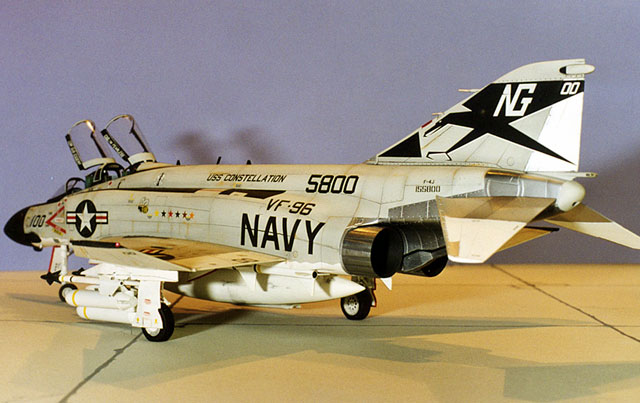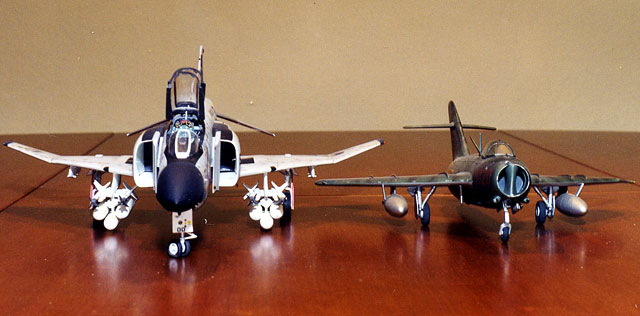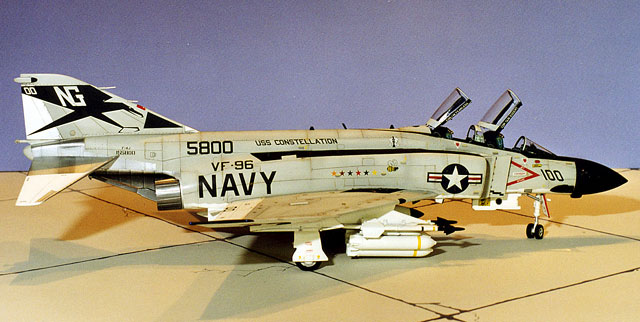|
F-4J Phantom
by
Ingo Degenhardt
|

|
|
"SHOWTIME 100"
Hasegawa’s F-4J in 1/48 |
Images by Lutz Degenhardt

Hasegawa's 1/48
scale F-4J Phantom is available online from Squadron.com
F-4J BuNo 155800, Callsign „Showtime 100“,VF-96 Fighting
Falcons, CVW-9, USS Constellation is probably the most ‚phamous‘ Phantom
of them all. This is tightly connected to the date of 10 May, 1972, when
this aircraft, flown by Lt. R. Cunningham and LTJG W.P. Driscoll
launched from Constellation for a mission over North Vietnam.
They accompanied an Alpha Strike with their F-4 loaded for Flak
suppression. With their bombs dropped on a secondary target, they became
almost immediately engaged with North Vietnamese Migs.
In the action that followed, Cunningham and Driscoll, already double Mig
killers, shot down three Mig-17s.

With their five victories in total, they became the US
Navy’s first aces of the Vietnam war.
On their egress route from North Vietnam several SAMs
were fired at them an one exploded close enough to cause lethal damage
to Showtime 100. Still they were able to fly the crippled Phantom out
over the gulf of Tonkin, were it finally had to be ditched – with
Cunningham and Driscoll rescued by Marine helicopters off the USS
Constellation.
Hasegawa’s F-4J is one their old Phantom kits updated to
more modern standards by reissuing it with engraved panel lines. To me,
this F-4 series (engraved or raised panel lines) still provides the best
1/48 Phantoms, although I started building them back in the mid 1980’s.
I do not know if the mouldings now begin to show their age whether it is
another reason, but some of the engraved panel lines, especially on the
aircraft’s spine were hardly visible. Fortunately this is a ‘sanding
area’ anyway and so there had to be some rescribing.

To produce a correct Navy ‘J’ version, the moulded-on
formation lights had to be removed. As well the reinforcing triangles on
the horizontal stabilizers. All three spine-mounted antennas are shown
in the construction leaflet, but only one is on the model. So the other
two had to be scratchbuilt.
The model was built as it comes out of the box except for a set of
TrueDetails Wheels (No.48051) to give the impression of a loaded
aircraft. The cockpit received some extra detailing with the etched
metal parts of one of Hasegawas old ‘Collector’s High Grade Series’.
I wished to show the Phantom as exactly as possible the
way it must have looked prior to takeoff from Constellation – four
Sidewinders, two Sparrows, six Rockeyes and the 600gal. centerline fuel
tank. Except for the Mk20 Rockeyes and the TER’s, coming from Hasegawa’s
Weapon Set A, everything is provided in the kit.
Painting,
Weathering and Decals
|
Painting
Preparing the model for painting started with polishing
the exhaust area and inner parts of horizontal stabilizers with a
polishing device and a Dremel tool.
With these surfaces now nearly ‘scratch free’, they were
sprayed with Testor’s Metalizer paints. These paints show no mercy with
a scratched or rough surface, as they only give a very thin coat. Hence
the polishing.
The masking for the several shades of metal-Colour was
done with paper (post-it). Afterwards the surface was hand-polished to
very nice natural metal shine. To protect it for the necessary masking
it was finally oversprayed with Testor’s Sealer for Metalizer.

With the appropriate sections masked off, the model
received a very light overspray in flat white as a basecoat.
As a side effect, this base coat clearly shows minor
errors in all filled, sanded or rescribed areas that can still be
corrected prior to the final colors being applied.
The remaining painting sequence was:
As far as I could find out, Showtime 100 had black
walkways instead of the dark Gull Grey used on most F-4J’s.
I was sure to have a set of decals from an F-4B in my
decal box, but that was not the case. All walkways therefore had to be
sprayed on this Phantom.
Weathering
As a first step the Xtracolor Gull Grey was lightened up
with a little gloss white before spraying the upper wings and fuselage.
The original Gull Grey from the can was used to spray thin faint lines
along all panel lines and a few patches, some sharp-edged, others
cloudy. This to simulate a slightly deteriorated Gull Grey and
re-paintings or replacement panels.
With all the spray-painting done and after a two days drying time, the
whole model received a ‘wash’ with heavily diluted dark grey for the
upper surfaces and dark brown for the white underside. Centerline fuel
tank and fuselage bottom in the engine area received a special treatment
with the wash to leave them more dirty than the rest of the aircraft.

Missiles and Cluster bombs were built and painted 'as
new'.
After the final clear flat coat (with the decals already on the model) a
little chipped paint was simulated here and there using ‘Treasure
Silver’ (a paste) and some powderized pastel chalk in a yellowish brown
was used to resemble some corrosion and dirt.
Decals
As markings for ‘Showtime 100’ are included in the kit’s
decal sheet, I used it for all markings.
Hasegawa’s decals for the plane today do not seem to be
quite accurate, so according to my sources I changed them to the look of
the aircraft on 10 May, 1972. It is believed that the silver Mig 21
inside the black triangle on the vertical fin was painted out just the
day before and got replaced by two little flags on the splinter plate.
So for that black triangle I used the decal for the
second marking option in the kit, another a/c from VF-96. The tiny red
flags with a yellow star were also included.
The decals were applied with the Microscale (Superscale)
system of Set and Sol. This works nearly always perfectly and only very
few cases of ‘silvering’ of the decals occurred with some of the ‘NO
STEP’ decals.
This is the latest of many 1/48 Phantoms that I have
built. A small selection of Navy-F-4s are shown below. There is also a
photo at the end that shows a comparison to the size of a Mig-17.


Model, Images and Text Copyright © 2002 by
Ingo Degenhardt
Page Created 27 December, 2002
Last Updated 04 June, 2007
Back to HyperScale
Main Page
Back to Features Index
|
Home
| What's New |
Features |
Gallery |
Reviews |
Reference |
Forum |
Search